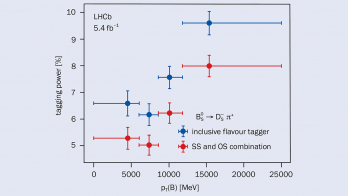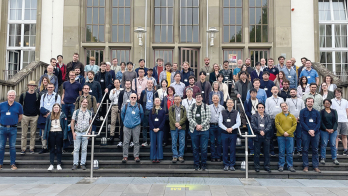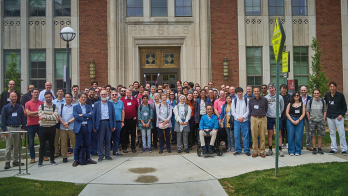
At the Flavor Physics and CP violation (FPCP) conference in Nagoya, the LHCb collaboration presented a measurement of the rate of B0 → D*+τ–ντ relative to the related decay B0→ D*+μ–νμ. The first measurement of any B → τX decay at a hadron collider, it also indicates a tantalizing anomaly.
In the Standard Model, the ratio of these two branching fractions differs from unity only as a result of effects related to the mass of the much heavier τ lepton. The ratio R(D*) = BR(B0 → D*+τ–ντ)/BR(B0 → D*+μ–νμ) is therefore precisely calculable in the Standard Model as equal to 0.252±0.003.
Lepton universality dictates that the electroweak coupling strength of the electron, muon and tau are identical, with the three flavours distinguished only by their respective masses. So the observation of decays with differing rates to each lepton flavour, after accounting for mass effects, would be a clear sign of physics beyond the Standard Model. Owing to the large τ mass, the semitauonic B0 → D*+τ–ντ decay rate is particularly sensitive to the charged Higgs bosons predicted by many extensions of the Standard Model. Previous measurements have consistently been above predictions, making new results hotly anticipated.
LHCb has analysed 3 fb–1 of data from Run 1 of the LHC to measure R(D*) using the τ → μνμντ decay, which allows both the semitauonic and semimuonic mode to be reconstructed in the same final state. The two decays are distinguished via a fit to the decay kinematics, reconstructed using the visible decay products and an approximation for the rest frame of the B (see figure). In addition to the B0 → D*+τ–ντ and B0 → D*+μ–νμ decays, the D*+μ–X final state also receives large contributions from several background processes. The modelling of these backgrounds in LHCb is constrained using control samples in data, strongly controlling uncertainties due to theoretical models. The result presented of 0.336±0.027±0.033 is in close agreement with a result from BaBar in 2012, and is 2.1σ away from the Standard Model prediction.
Between the results from LHCb, BaBar and the Belle collaboration – which also presented updated results at the conference – a tantalizing picture is emerging in this channel. LHCb already has plans for complementary measurements in the decays B– → D0τ–ντ and Λ0b → Λ+c τ–ντ with the LHC Run 1 data set, and data from Run 2 is expected to allow for exciting improvements.








